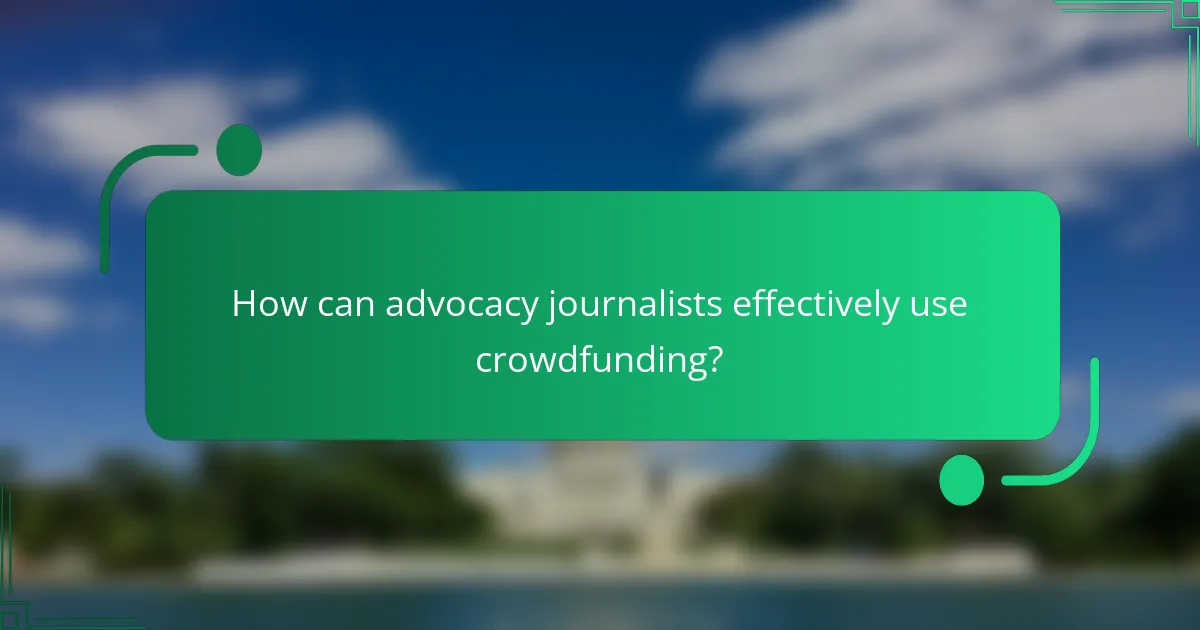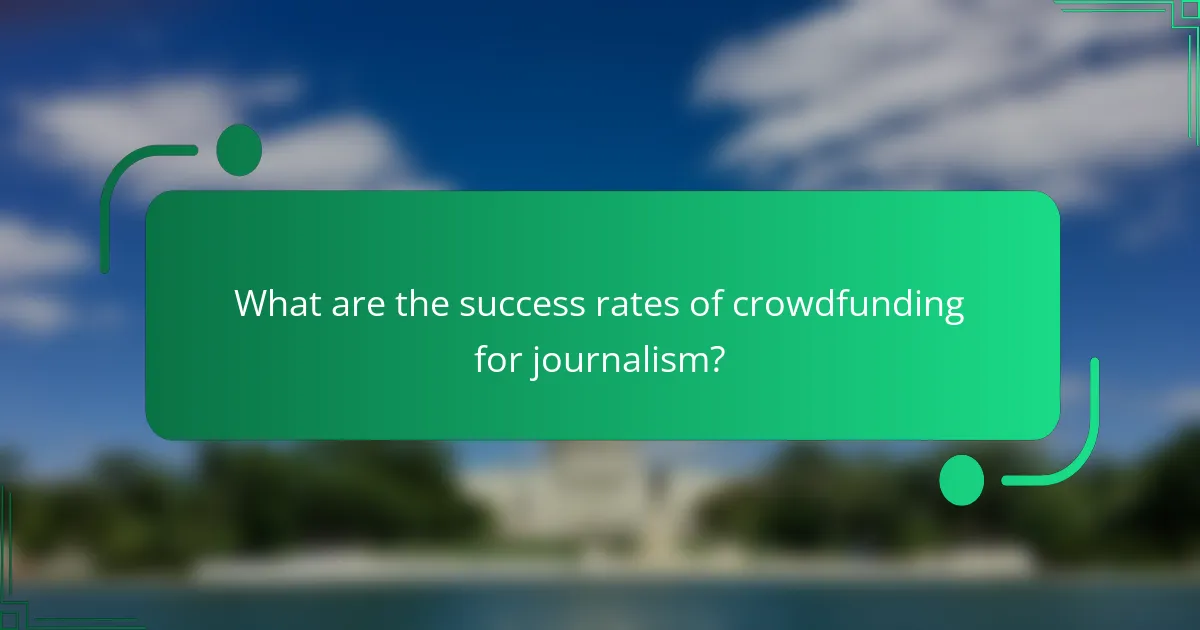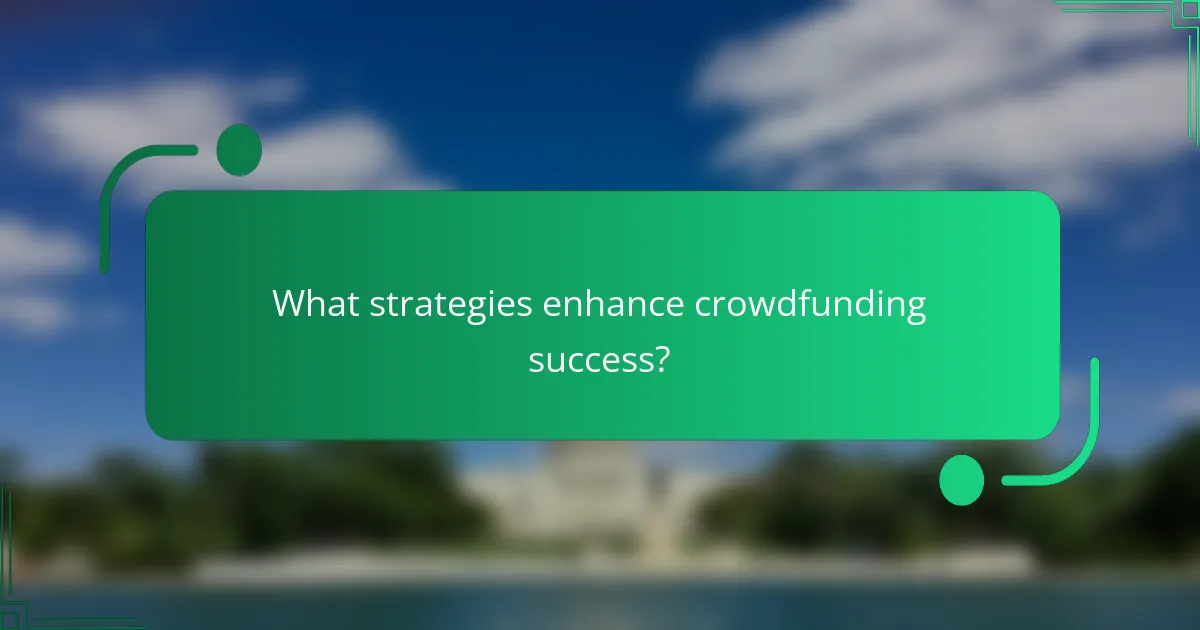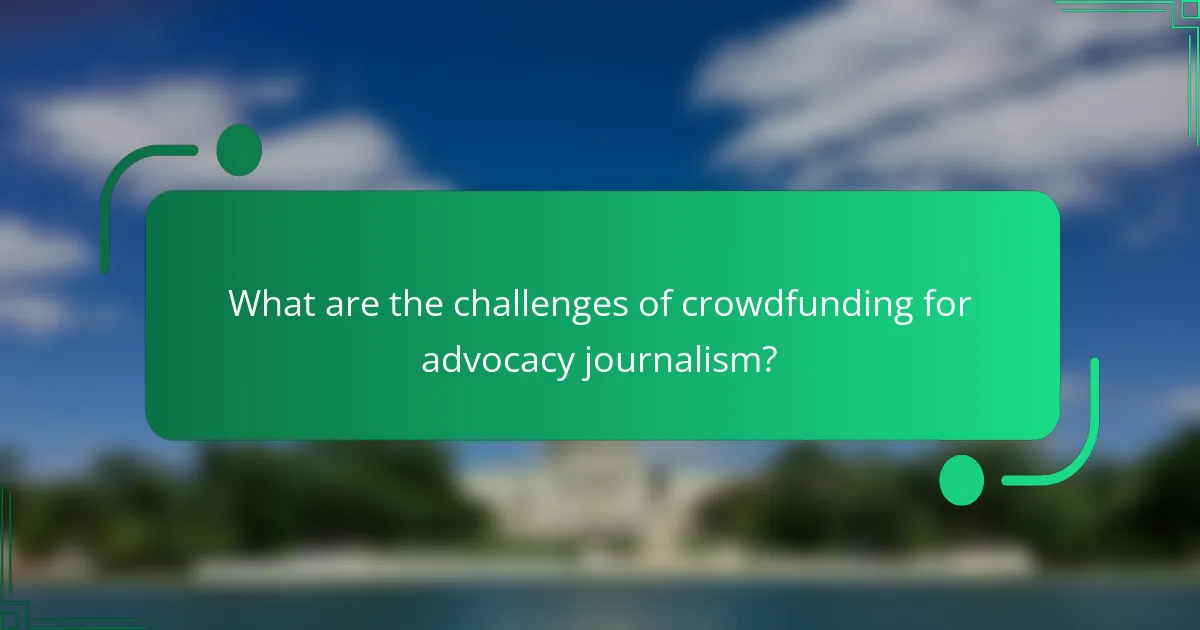Crowdfunding has emerged as a vital tool for advocacy journalism, providing creators with platforms to secure funding for impactful projects. By selecting the right platform and crafting compelling narratives, journalists can engage their audience and enhance their chances of success, with funding rates typically ranging from 30% to 60%. Understanding the nuances of these platforms and strategies is essential for maximizing support and achieving financial goals.

What crowdfunding platforms support advocacy journalism?
Several crowdfunding platforms are tailored to support advocacy journalism, allowing creators to raise funds for their projects. These platforms vary in structure, audience, and funding models, making it essential to choose one that aligns with your goals.
Kickstarter for journalism projects
Kickstarter is a popular platform for funding creative projects, including journalism initiatives. It operates on an all-or-nothing model, meaning that projects must reach their funding goal to receive any money. This can create urgency and motivate backers, but it also means that careful planning and realistic goal-setting are crucial.
Successful journalism projects on Kickstarter often include compelling video pitches and clear descriptions of the impact the project will have. For example, a documentary on a social issue may outline how funds will be used for production costs, travel, and distribution.
Indiegogo for media initiatives
Indiegogo offers more flexibility than Kickstarter, allowing projects to keep funds even if they don’t meet their goal. This can be advantageous for journalism initiatives that may require less stringent funding targets. Indiegogo also features a wider range of funding options, including fixed and flexible funding.
Media initiatives on Indiegogo can benefit from its global reach and diverse audience. Creators should focus on engaging storytelling and clear communication of their mission to attract backers. Examples include investigative reports or community journalism efforts that highlight local issues.
Patreon for ongoing support
Patreon is designed for creators seeking ongoing financial support from their audience. It allows journalists to establish a subscription model where supporters pay a monthly fee in exchange for exclusive content or behind-the-scenes access. This model is particularly effective for independent journalists or media outlets that produce regular content.
To succeed on Patreon, journalists should offer tiered membership levels with varying benefits, such as early access to articles, exclusive podcasts, or Q&A sessions. This approach fosters a loyal community and provides a steady income stream.
GoFundMe for specific campaigns
GoFundMe is ideal for raising funds for specific journalism campaigns or urgent projects. Unlike other platforms, it does not charge a platform fee for personal causes, making it accessible for individuals and small teams. This can be particularly useful for time-sensitive issues or emergency reporting.
When using GoFundMe, it’s important to clearly articulate the purpose of the campaign and how the funds will be used. Successful campaigns often share personal stories or urgent calls to action, such as funding for a series on human rights abuses or environmental crises.

How can advocacy journalists effectively use crowdfunding?
Advocacy journalists can effectively use crowdfunding by crafting engaging stories that resonate with potential backers, actively involving their audience, and setting achievable funding targets. This approach not only builds community support but also enhances the likelihood of reaching financial goals.
Creating compelling narratives
Compelling narratives are essential for successful crowdfunding in advocacy journalism. Journalists should focus on storytelling that highlights the importance of their work, the issues at stake, and the impact of potential funding. Using vivid descriptions and personal anecdotes can draw in supporters and make them feel invested in the cause.
Consider structuring the narrative around a central theme or question that resonates with the audience. For instance, a journalist might ask, “How can we hold powerful entities accountable?” This approach invites potential funders to see their contribution as a direct investment in meaningful change.
Engaging with the audience
Engagement is crucial for building a supportive community around a crowdfunding campaign. Journalists should actively communicate with their audience through social media, newsletters, and updates on the crowdfunding platform. Regular interaction helps maintain interest and encourages backers to share the campaign with their networks.
Incorporating feedback from supporters can also enhance engagement. For example, asking for input on story angles or topics can make backers feel valued and more likely to contribute. Creating a sense of ownership among supporters fosters loyalty and increases the chances of reaching funding goals.
Setting realistic funding goals
Setting realistic funding goals is vital for the success of a crowdfunding campaign. Journalists should assess the costs associated with their projects, including research, production, and distribution expenses. A well-defined budget helps in determining a reasonable funding target that reflects the project’s needs.
It’s advisable to break down larger goals into smaller milestones. For instance, a campaign might aim for an initial target of $5,000 to cover preliminary research, followed by additional goals for further phases of the project. This strategy not only makes the goals more attainable but also allows for celebrating small victories along the way.

What are the success rates of crowdfunding for journalism?
The success rates of crowdfunding for journalism can vary significantly, often falling between 30% to 60% for campaigns that reach their funding goals. Factors such as campaign visibility, the strength of the pitch, and the engagement of the target audience play critical roles in determining these rates.
Statistics on successful campaigns
Research indicates that successful crowdfunding campaigns for journalism typically raise anywhere from a few thousand to several hundred thousand dollars. Platforms like Kickstarter and Indiegogo report that campaigns with clear goals and compelling narratives tend to perform better, with some achieving funding levels exceeding 200% of their targets.
Additionally, campaigns that offer tangible rewards or incentives to backers often see higher success rates. For instance, projects that provide exclusive content or early access to articles can attract more supporters.
Factors influencing success
Several key factors influence the success of crowdfunding campaigns for journalism. First, a well-defined target audience is crucial; understanding who will support the project can guide marketing strategies and outreach efforts. Second, the quality of the campaign presentation, including visuals and storytelling, can significantly impact backer engagement.
Moreover, timing plays a vital role. Launching a campaign during relevant news cycles or events can boost visibility and support. Building a community around the project before the launch can also enhance credibility and encourage initial funding.
Case studies of successful journalism campaigns
One notable example is the “The Guardian’s” crowdfunding initiative for investigative journalism, which successfully raised over $1 million. This campaign highlighted the importance of transparency and community engagement, drawing in supporters who valued independent reporting.
Another successful case is “ProPublica,” which has utilized crowdfunding to support specific investigative projects. Their approach combines storytelling with a clear demonstration of impact, effectively rallying public support and funding.

What strategies enhance crowdfunding success?
Successful crowdfunding for advocacy journalism often hinges on effective strategies that engage potential backers and create a sense of community. Key approaches include leveraging social media, fostering a dedicated community, and providing attractive rewards for supporters.
Utilizing social media for promotion
Social media platforms are essential for promoting crowdfunding campaigns, as they allow for direct engagement with potential supporters. Utilize platforms like Twitter, Facebook, and Instagram to share updates, behind-the-scenes content, and personal stories related to your project.
Consider creating a content calendar to maintain a consistent posting schedule. Engaging visuals and compelling narratives can significantly increase shares and interactions, expanding your reach beyond your immediate network.
Building a community around the project
Creating a sense of community is crucial for sustaining interest and support throughout your crowdfunding campaign. Engage with your audience by responding to comments, hosting live Q&A sessions, and encouraging discussions about the issues your journalism addresses.
Consider establishing a dedicated online space, such as a Facebook group or a Discord server, where backers can connect and share their thoughts. This fosters loyalty and encourages backers to become advocates for your project, potentially bringing in new supporters.
Offering rewards for backers
Offering rewards can incentivize potential backers to contribute to your crowdfunding campaign. Rewards can range from digital content, such as exclusive articles or podcasts, to physical items like branded merchandise or limited-edition prints.
Ensure that the rewards are appealing and relevant to your audience. Setting tiered rewards can also encourage larger contributions; for example, a $10 donation might earn a thank-you email, while a $50 donation could provide access to exclusive content. Be mindful of the costs associated with fulfilling these rewards to maintain a sustainable budget.

What are the challenges of crowdfunding for advocacy journalism?
Crowdfunding for advocacy journalism faces several challenges that can impact its effectiveness and sustainability. Key issues include competition for funding, the need for transparency with backers, and the fees associated with crowdfunding platforms.
Competition for funding
The landscape of crowdfunding is crowded, with numerous projects vying for the same pool of potential backers. Advocacy journalism projects must clearly differentiate themselves to attract funding, often requiring compelling narratives and unique angles to stand out.
Many backers prefer projects that align with their personal interests or values, making it essential for journalists to target their outreach effectively. Building a strong community around the project can enhance visibility and support, increasing the chances of successful funding.
Maintaining transparency with backers
Transparency is crucial in crowdfunding, as backers want to know how their contributions will be used. Advocacy journalism projects should provide clear budgets, timelines, and updates to maintain trust and engagement with supporters.
Regular communication about project progress and challenges can help foster a loyal backer community. Consider using platforms that facilitate direct interaction with supporters, allowing for feedback and questions to be addressed promptly.
Dealing with platform fees
Most crowdfunding platforms charge fees that can range from 5% to 10% of the total funds raised, which can significantly impact the final amount available for the project. It’s important to factor these fees into the funding goal to ensure sufficient resources for the advocacy journalism effort.
Some platforms offer lower fees or different structures, such as all-or-nothing funding models, which can influence the decision on where to launch a campaign. Evaluating the fee structures of various platforms can help maximize the funds available for the project.

How does crowdfunding impact journalistic integrity?
Crowdfunding can significantly influence journalistic integrity by providing financial support while also raising concerns about potential biases. When journalists rely on public contributions, they may face pressure to cater to the interests of their funders, which can compromise their objectivity.
Balancing funding with editorial independence
Maintaining editorial independence while securing funding through crowdfunding is crucial for journalists. It is essential to establish clear guidelines that separate funding sources from content creation to avoid conflicts of interest. Transparency about funding sources can help build trust with the audience.
Journalists should consider adopting a mixed funding model, combining crowdfunding with traditional revenue streams such as subscriptions or grants. This approach can reduce reliance on any single funding source and help maintain editorial integrity.
Common pitfalls include failing to disclose funding sources or allowing funders to influence editorial decisions. Journalists should prioritize their commitment to truth and accuracy, ensuring that their reporting remains unbiased and serves the public interest.
